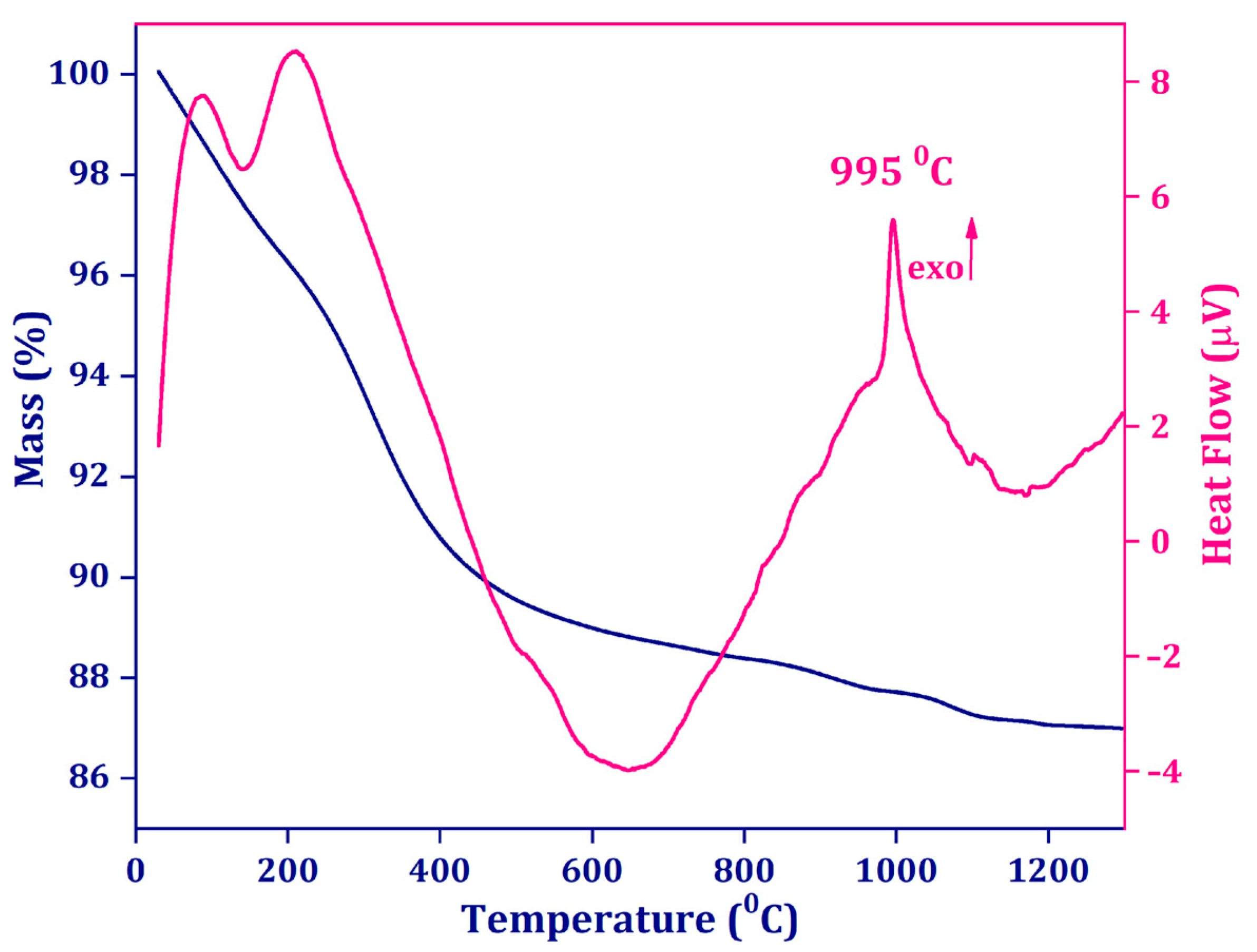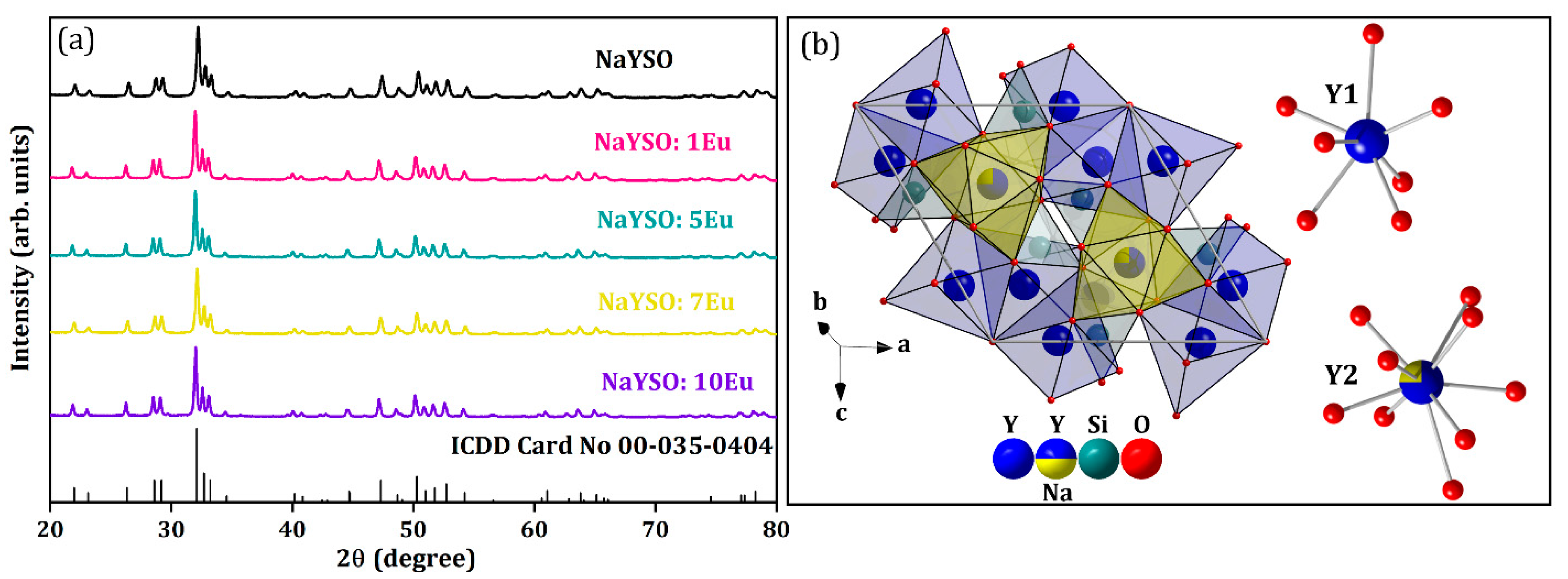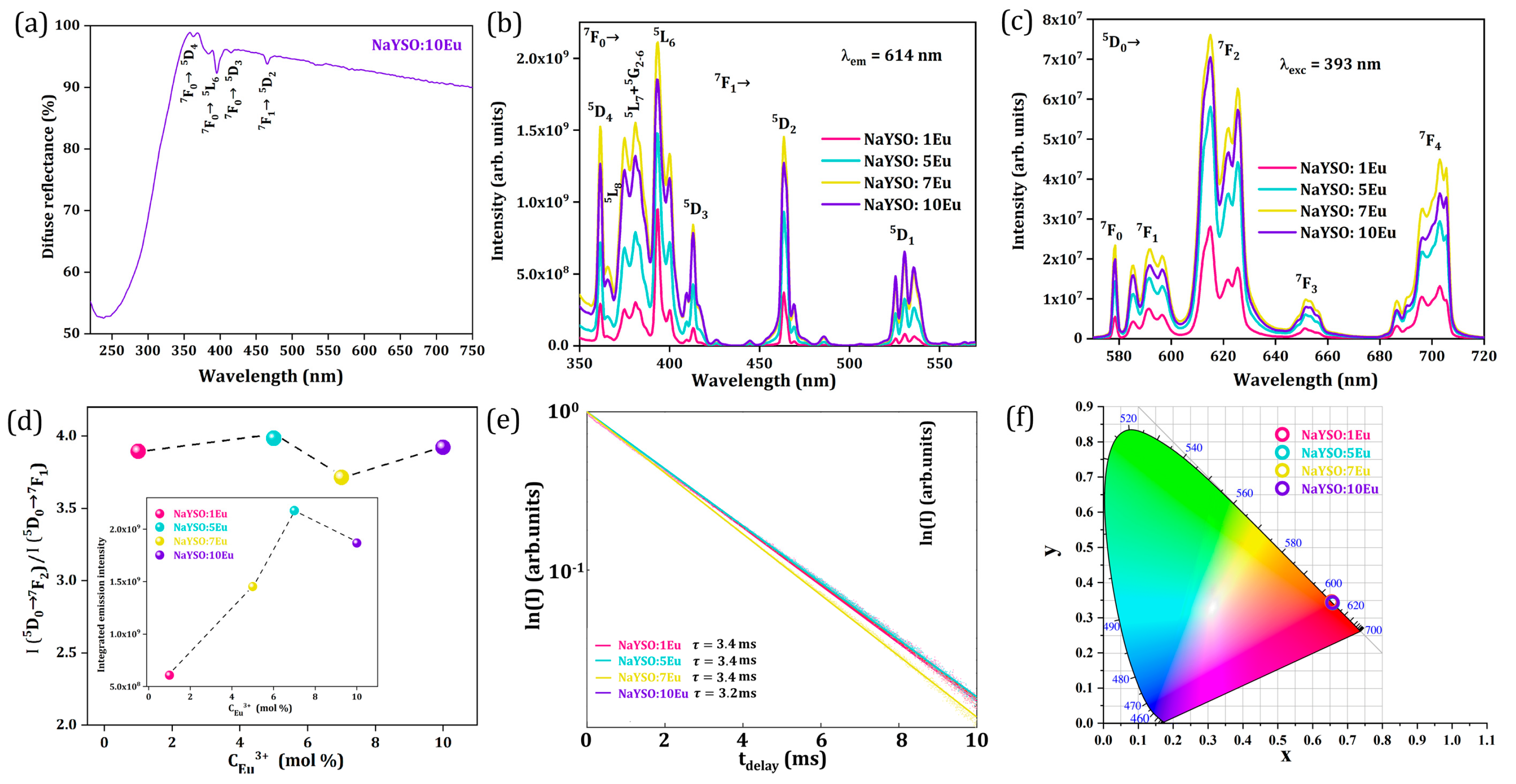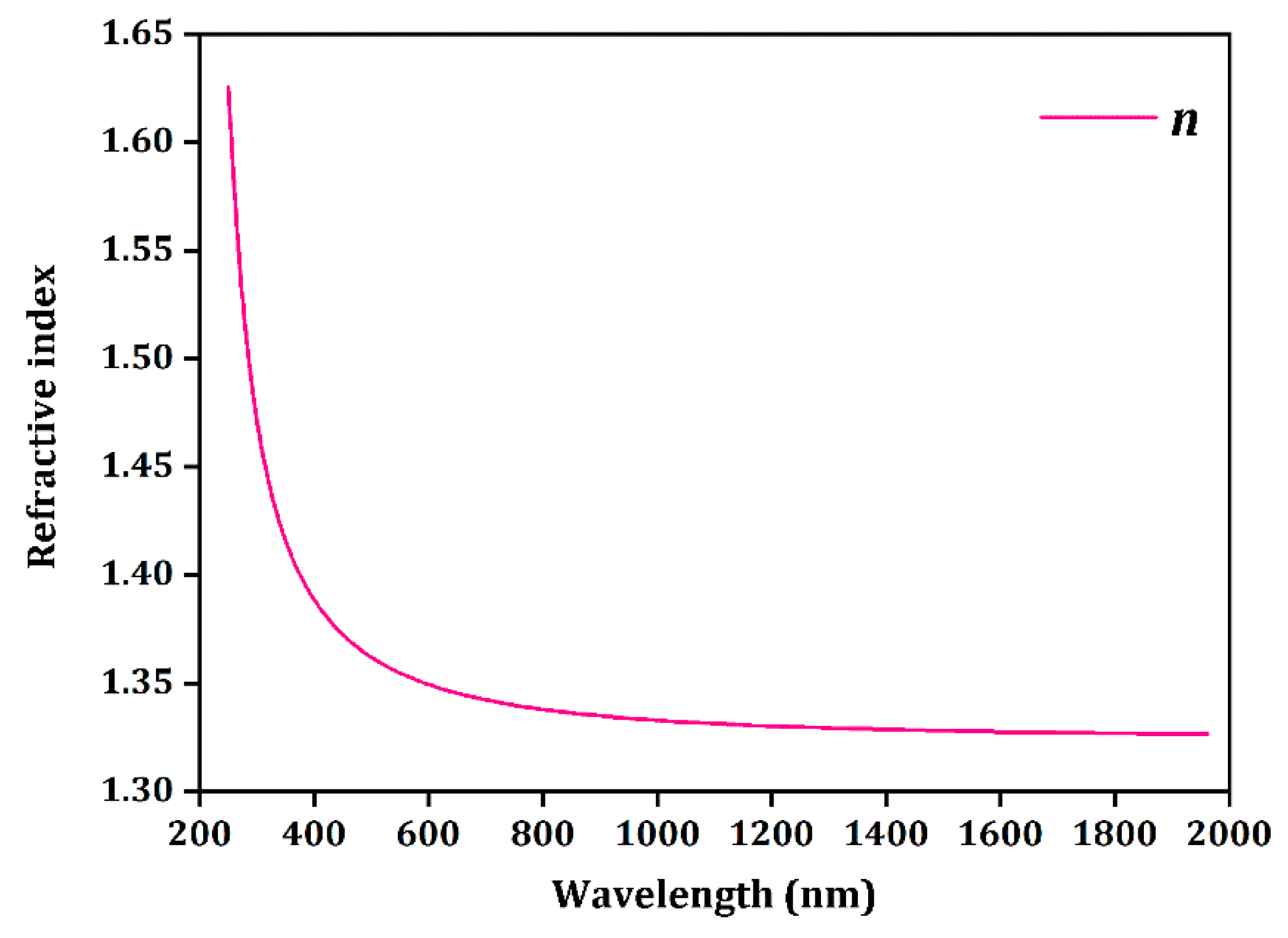Nanosized Eu3+-Doped NaY9Si6O26 Oxyapatite Phosphor: A Comprehensive Insight into Its Hydrothermal Synthesis and Structural, Morphological, Electronic, and Optical Properties
Abstract
1. Introduction
2. Materials and Methods
2.1. Hydrothermal Synthesis of Undoped and Eu3+-Doped Apatite Samples
2.2. Characterization of the Apatite Materials
3. Results and Discussion
3.1. Thermal Stability (TGA) and Differential Thermal Analysis (DTA)
3.2. Structural Characterization
3.3. Microstructural Characterization by Electron Microscopy (SEM and TEM)
3.4. Calculations of the Structural and Electronic Properties
3.5. Optical Spectroscopy
3.6. The Judd–Ofelt Calculation
4. Conclusions
Author Contributions
Funding
Data Availability Statement
Conflicts of Interest
References
- Ptáček, P. Apatites and Their Synthetic Analogues-Synthesis, Structure, Properties and Applications; Intech Open: London, UK, 2016. [Google Scholar] [CrossRef]
- Anil; Kumar, B.; Barwar, A.; Barbar, S.K. Structural, Optical and Photoluminescence Characteristics of Apatite Type Lanthanide Silicates. J. Mol. Struct. 2024, 1312, 138607. [Google Scholar] [CrossRef]
- Kobayashi, K.; Sakka, Y. Rudimental Research Progress of Rare-Earth Silicate Oxyapatites: Their Identification as a New Compound until Discovery of Their Oxygen Ion Conductivity. J. Ceram. Soc. Jpn. 2014, 122, 649–663. [Google Scholar] [CrossRef]
- Neeway, J.J.; Asmussen, R.M.; McElroy, E.M.; Peterson, J.A.; Riley, B.J.; Crum, J.V. Kinetics of Oxyapatite [Ca2Nd8(SiO4)6O2] and Powellite [(Ca,Sr,Ba)MoO4] Dissolution in Glass-Ceramic Nuclear Waste Forms in Acidic, Neutral, and Alkaline Conditions. J. Nucl. Mater. 2019, 515, 227–237. [Google Scholar] [CrossRef]
- Liu, H.; Liao, L.; Pan, X.; Su, K.; Shuai, P.; Yan, Z.; Guo, Q.; Mei, L. Recent Research Progress of Luminescent Materials with Apatite Structure: A Review. Open Ceram. 2022, 10, 100251. [Google Scholar] [CrossRef]
- Sumathi, S.; Gopal, B. A New Insight into Biomedical Applications of an Apatite like Oxyphosphate–BiCa4(PO4)3O. Ceram. Int. 2015, 41, 4852–4860. [Google Scholar] [CrossRef]
- Chuai, X.H.; Zhang, H.J.; Li, F.S.; Lu, S.Z.; Lin, J.; Wang, S.B.; Chi-Chou, K. Synthesis and Luminescence Properties of Oxyapatite NaY9Si6O26 Doped with Eu3+, Tb3+, Dy3+ and Pb2+. J. Alloys Compd. 2002, 334, 211–218. [Google Scholar] [CrossRef]
- Kang, T.W.; Choi, Y.B.; Kang, C.H.; Park, Y.J.; Kim, J.H.; Bae, B.; Kim, S.W. Development of NaY9Si6O26:Yb3+ Phosphors with High Thermal Stability for NIR Anti-Counterfeiting: Study of Its Crystal Structure and Luminescent Properties. RSC Adv. 2023, 13, 7597–7602. [Google Scholar] [CrossRef]
- Zheng, L.; Zheng, B.; Xia, H.; Wang, J.; Song, H.; Chen, B. Color-Tunable Emission and Non-Contact Optical Temperature Sensing Performance in NaY9Si6O26: Ce3+, Eu3+ Phosphors. Mater. Res. Bull. 2021, 138, 111210. [Google Scholar] [CrossRef]
- Zheng, L.; Zhou, X.; Zhang, J.; Xia, H.; Song, H.; Chen, B. Multiple Occupation Sites of Bi3+ and Full Color Luminescence Tuning through Co-Doped Eu3+ in NaY9Si6O26 Phosphors. J. Alloys Compd. 2020, 847, 156575. [Google Scholar] [CrossRef]
- Brgoch, J.; Borg, C.K.H.; Denault, K.A.; Douglas, J.R.; Amanda Strom, T.; DenBaars, S.P.; Seshadri, R. Rapid Microwave Preparation of Cerium-Substituted Sodium Yttrium Silicate Phosphors for Solid State White Lighting. Solid State Sci. 2013, 26, 115–120. [Google Scholar] [CrossRef]
- Preparation Method of Fusiform Apatite Phase Y4.67(SiO4)3O Powder, CN105776231A. Available online: https://patents.google.com/patent/CN105776231A/en?oq=CN105776231A (accessed on 12 September 2024).
- Wang, Q.-G.; Huang, J.-F.; Zhou, L.; Wu, W.-C.; Cao, L.-Y. Thermal Property of Y4.67 (SiO4)3 Ceramic Sintered from Hydrothermally Synthesized Spindle-like Y4.67(SiO4)3O Apatite Crystallites. J. Inorg. Mater. 2018, 33, 688–692. [Google Scholar] [CrossRef]
- Gu, H.; Hou, X.; Zhang, R.; Fang, D. Novel High-temperature-resistant Y2SiO5 Aerogel with Ultralow Thermal Conductivity. Int. J. Appl. Ceram. Technol. 2019, 16, 2393–2397. [Google Scholar] [CrossRef]
- Boyer, D.; Derby, B. Yttrium Silicate Powders Produced by the Sol–Gel Method, Structural and Thermal Characterization. J. Am. Ceram. Soc. 2003, 86, 1595–1597. [Google Scholar] [CrossRef]
- Krsmanović, R.W.; Andrić, Ž.; Marinović-Cincović, M.; Zeković, I.; Dramićanin, M.D. Optical and Thermal Investigation of Sol-Gel Derived Eu3+: Y2SiO5 Nanoparticles. Acta Phys. Polonica. A 2007, 112, 981–986. [Google Scholar] [CrossRef]
- Moya, J.S.; Díaz, M.; Serna, C.J.; Mello-Castanho, S. Formation of Nanocrystalline Yttrium Disilicate Powder by an Oxalate Gel Method. J. Eur. Ceram. Soc. 1998, 18, 1381–1384. [Google Scholar] [CrossRef]
- Jo, S.H.; Muralidharan, P.; Kim, D.K. Low-Temperature Sintering of Dense Lanthanum Silicate Electrolytes with Apatite-Type Structure Using an Organic Precipitant Synthesized Nanopowder. J. Mater. Res. 2009, 24, 237–244. [Google Scholar] [CrossRef]
- Tao, S.; Irvine, J.T.S. Preparation and Characterisation of Apatite-Type Lanthanum Silicates by a Sol-Gel Process. Mater. Res. Bull. 2001, 36, 1245–1258. [Google Scholar] [CrossRef]
- Li, J.; Cai, Q.; Horri, B.A. Synthesis and Densification of Mo/Mg Co-Doped Apatite-type Lanthanum Silicate Electrolytes with Enhanced Ionic Conductivity. Chem. A Eur. J. 2023, 29, e202300021. [Google Scholar] [CrossRef]
- Shannon, R.D. Revised Effective Ionic Radii and Systematic Studies of Interatomic Distances in Halides and Chalcogenides. Acta Crystallogr. A 1976, 32, 751–767. [Google Scholar] [CrossRef]
- Lee, F.C.; Marr, J.; Glasser, F.P. Compounds in the Na2O Y2O3 SiO2 System. Ceram. Int. 1981, 7, 43–47. [Google Scholar] [CrossRef]
- Redhammer, G.R.; Roth, G. Lithium and Sodium Yttrium Orthosilicate Oxyapatite, LiY9(SiO4)6O2 and NaY9(SiO4)6O2, at Both 100 K and near Room Temperature. Acta Crystallogr. C 2003, 59, i120–i124. [Google Scholar] [CrossRef] [PubMed]
- Clark, S.J.; Segall, M.D.; Pickard, C.J.; Hasnip, P.J.; Probert, M.I.J.; Refson, K.; Payne, M.C. First Principles Methods Using CASTEP. Z. Für Krist. -Cryst. Mater. 2005, 220, 567–570. [Google Scholar] [CrossRef]
- Perdew, J.P.; Burke, K.; Ernzerhof, M. Generalized Gradient Approximation Made Simple. Phys. Rev. Lett. 1996, 77, 3865–3868. [Google Scholar] [CrossRef] [PubMed]
- Ceperley, D.M.; Alder, B.J. Ground State of the Electron Gas by a Stochastic Method. Phys. Rev. Lett. 1980, 45, 566–569. [Google Scholar] [CrossRef]
- Binnemans, K.; Görller-Walrand, C. Application of the Eu3+ ion for site symmetry determination. J. Rare Earths 1996, 14, 173–180. [Google Scholar]
- Malta, O.L.; Antic-Fidancev, E.; Lemaitre-Blaise, M.; Milicic-Tang, A.; Taibi, M. The Crystal Field Strength Parameter and the Maximum Splitting of the 7F1 Manifold of the Eu3+ Ion in Oxides. J. Alloys Compd. 1995, 228, 41–44. [Google Scholar] [CrossRef]
- Monteil, A.; El-Jouad, M.; Alombert-Goget, G.; Chaussedent, S.; Gaumer, N.; Mahot, A.; Chiasera, A.; Jestin, Y.; Ferrari, M. Relationship between Structure and Optical Properties in Rare Earth-Doped Hafnium and Silicon Oxides: Modeling and Spectroscopic Measurements. J. Non-Cryst. Solids 2008, 354, 4719–4722. [Google Scholar] [CrossRef]
- Zhu, C.; Monteil, A.; EI-Jouad, M.; Gaumer, N.; Chaussedent, S. Influence of Thermal Treatment on Optical and Structure Properties of Europium-Doped SiO2–HfO2 Glasses. J. Am. Ceram. Soc. 2010, 93, 1039–1043. [Google Scholar] [CrossRef]
- Ćirić, A.; Stojadinović, S.; Sekulić, M.; Dramićanin, M.D. JOES: An Application Software for Judd-Ofelt Analysis from Eu3+ Emission Spectra. J. Lumin. 2019, 205, 351–356. [Google Scholar] [CrossRef]
- Ćirić, A.; Marciniak, Ł.; Dramićanin, M.D. Self-Referenced Method for the Judd–Ofelt Parametrisation of the Eu3+ Excitation Spectrum. Sci. Rep. 2022, 12, 563. [Google Scholar] [CrossRef]
- Binnemans, K. Interpretation of Europium(III) Spectra. Coord. Chem. Rev. 2015, 295, 1–45. [Google Scholar] [CrossRef]
- Walsh, B.M. Judd-Ofelt Theory: Principles and Practices. In Advances in Spectroscopy for Lasers and Sensing; Di Bartolo, B., Forte, O., Eds.; Springer: Dordrecht, The Netherlands, 2006; pp. 403–433. ISBN 978-1-4020-4788-6. [Google Scholar]






| Sample Code | Eu3+ (mol %) | Molecular Formula |
|---|---|---|
| NaYSO | 0 | NaY9Si6O26 |
| NaYSO:1Eu | 1 | NaY8.91Eu0.09Si6O26 |
| NaYSO:5Eu | 5 | NaY8.55Eu0.45Si6O26 |
| NaYSO:7Eu | 7 | NaY8.37Eu0.63Si6O26 |
| NaYSO:10Eu | 10 | NaY8.1Eu0.9Si6O26 |
| Material | Synthesis | Structure | Total Weight Loss | Crystallization T (°C) | Reference |
|---|---|---|---|---|---|
| Y2SiO5 | Sol-gel | Monoclinic | ~29.3% | ~1040 | [14] |
| Y2SiO5 | Sol-gel | Monoclinic X1—Y2SiO5 X2—Y2SiO5 | ~30% | ~1010 ~1360 | [15] |
| Y2SiO5 | Sol-gel | Monoclinic X1—Y2SiO5 X2—Y2SiO5 | ~70% | ~1025 ~1350 | [16] |
| Y2Si2O7 | Oxalate gel | Monoclinic α—Y2Si2O7 | ~60% | ~1065 | [17] |
| La10Si6O27 | Precipitation | Hexagonal | ~21.4% | ~902 | [18] |
| La10Si6O27 | Sol-gel | Hexagonal | ~48.4% | ~959 | [19] |
| La9.5Si6O26.25 | Co-precipitation | Hexagonal | ~26.5% | ~883 | [20] |
| La9.33Si6O26 | Sol-gel | Hexagonal | ~48.4% | ~874 | [19] |
| NaY9Si6O26 | Hydrothermal | Hexagonal | ~13% | ~995 | This work |
| ICDD Card 00-035-0404 | NaYSO | NaYSO: 1Eu | NaYSO: 5Eu | NaYSO: 7Eu | NaYSO: 10Eu |
|---|---|---|---|---|---|
| a = b (Å) | 9.3398 (10) | 9.3539 (13) | 9.3504 (7) | 9.3483 (15) | 9.3511 (5) |
| c (Å) | 6.7508 (8) | 6.7571 (10) | 6.7610 (5) | 6.7611 (11) | 6.7769 (5) |
| CS (Å) | 181 (2) | 212 (3) | 233 (3) | 219 (2) | 282 (3) |
| Strain | 0.28 (5) | 0.23 (6) | 0.21 (4) | 0.22 (4) | 0.17 (3) |
| Rwp | 12.56 | 12.37 | 10.69 | 9.86 | 9.69 |
| Rp | 8.86 | 8.60 | 7.46 | 7.0 | 6.78 |
| Re | 3.35 | 3.17 | 3.13 | 3.13 | 2.99 |
| GOF | 3.7449 | 3.8971 | 3.4905 | 3.2399 | 3.2399 |
| 7F0 | 7F1 | 7F2 | 7F3 | 7F4 | ||
|---|---|---|---|---|---|---|
| 0 | 207 | 1026 | 1854 | 2719 | ||
| 380 | 1209 | 1937 | 2804 | |||
| [cm−1] | 522 | 1299 | 1984 | 2928 | ||
| 2042 | 3061 | |||||
| 3112 | ||||||
| 5D0 | 5D1 | 5D2 | 5D3 | 5L6 | 5L7 + G2–6 | 5L8, 5D4 |
| 17,286 | 18,657 | 21,322 | 24,213 | 25,000 | 26,110 | 27,322 |
| 18,850 | 21,575 | 24,420 | 25,413 | 26,247 | 27,662 | |
| 19,029 | 26,667 |
| C [%] | Ω2∙1020 [cm2] | Ω4∙1020 [cm2] | Ω6∙1020 [cm2] | A1 [s−1] | A2 [s−1] | A4 [s−1] | β1 [%] | β2 [%] | β4 [%] | τR [ms] | τ [ms] | η [%] |
|---|---|---|---|---|---|---|---|---|---|---|---|---|
| 1 | 6.5 | 6.51 | 1.31 | 35.5 | 139.4 | 68.1 | 14.6 | 57.4 | 28 | 4.1 | 3.4 | 83 |
| 5 | 6.66 | 6.45 | 0.69 | 35.5 | 142.7 | 67.4 | 14.5 | 58.1 | 27.4 | 4.1 | 3.4 | 83 |
| 7 | 6.22 | 6.37 | 0.632 | 35.5 | 133.2 | 66.6 | 15.1 | 56.6 | 28.3 | 4.3 | 3.4 | 79 |
| 10 | 6.57 | 6.05 | 0.494 | 35.5 | 140.6 | 63.2 | 14.8 | 58.7 | 26.4 | 4.2 | 3.2 | 76 |
Disclaimer/Publisher’s Note: The statements, opinions and data contained in all publications are solely those of the individual author(s) and contributor(s) and not of MDPI and/or the editor(s). MDPI and/or the editor(s) disclaim responsibility for any injury to people or property resulting from any ideas, methods, instructions or products referred to in the content. |
© 2024 by the authors. Licensee MDPI, Basel, Switzerland. This article is an open access article distributed under the terms and conditions of the Creative Commons Attribution (CC BY) license (https://creativecommons.org/licenses/by/4.0/).
Share and Cite
Ivanovici, M.; Ćirić, A.; Periša, J.; Marinović Cincović, M.; Brik, M.G.; Alodhayb, A.N.; Antić, Ž.; Dramićanin, M.D. Nanosized Eu3+-Doped NaY9Si6O26 Oxyapatite Phosphor: A Comprehensive Insight into Its Hydrothermal Synthesis and Structural, Morphological, Electronic, and Optical Properties. Nanomaterials 2024, 14, 1639. https://doi.org/10.3390/nano14201639
Ivanovici M, Ćirić A, Periša J, Marinović Cincović M, Brik MG, Alodhayb AN, Antić Ž, Dramićanin MD. Nanosized Eu3+-Doped NaY9Si6O26 Oxyapatite Phosphor: A Comprehensive Insight into Its Hydrothermal Synthesis and Structural, Morphological, Electronic, and Optical Properties. Nanomaterials. 2024; 14(20):1639. https://doi.org/10.3390/nano14201639
Chicago/Turabian StyleIvanovici, Madalina, Aleksandar Ćirić, Jovana Periša, Milena Marinović Cincović, Mikhail G. Brik, Abdullah N. Alodhayb, Željka Antić, and Miroslav D. Dramićanin. 2024. "Nanosized Eu3+-Doped NaY9Si6O26 Oxyapatite Phosphor: A Comprehensive Insight into Its Hydrothermal Synthesis and Structural, Morphological, Electronic, and Optical Properties" Nanomaterials 14, no. 20: 1639. https://doi.org/10.3390/nano14201639
APA StyleIvanovici, M., Ćirić, A., Periša, J., Marinović Cincović, M., Brik, M. G., Alodhayb, A. N., Antić, Ž., & Dramićanin, M. D. (2024). Nanosized Eu3+-Doped NaY9Si6O26 Oxyapatite Phosphor: A Comprehensive Insight into Its Hydrothermal Synthesis and Structural, Morphological, Electronic, and Optical Properties. Nanomaterials, 14(20), 1639. https://doi.org/10.3390/nano14201639













